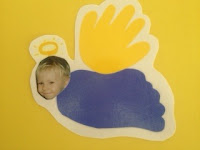I hope each of
you had a glorious Thanksgiving!
Were you in the crowd that stayed up until midnight to get those
bargains? Some people play tennis. Some people run races. Some people enjoy the thrill of getting
a good deal!
My husband and
I were on our way to our son’s for Thanksgiving and I started singing, “Here we
go…” He finished by singing, “Up a
row to a birthday party.” Then we both
sang, “Dolly dear, sandman’s near.
We will soon be sleeping.”
Now this won’t mean a thing to most of you, but anyone who took piano
lessons in the 50’s or 60’s probably started with a book called “Teaching
Little Fingers to Play.” The first
songs we learned were “Here we go…” and “Dolly dear…” My husband and I have a hard time remembering our names some
days (just kidding!), but isn’t it interesting that music we learned over 55
years ago is still alive inside our heads? That’s why singing is such a magical way for children to
learn.
We’re having a
neighborhood party this week and the theme is “Leave It to Beaver.” We’re having “retro” foods from the
50’s and 60’s (congealed salad,
meatloaf, mac and cheese, pudding, etc.) and I’ve ordered a “Sing along
with Mitch” DVD for entertainment.
Oh, what fun we used to having sitting around and singing with Mitch as
the little ball bounced over the words!
Talk about fluency fun!
But nobody sings
any more, and that’s a sad thing because these children need a song in their
hearts! So to start off the
holiday season, here are a few songs to share this coming month. And although your students might forget
90% of what you teach them, I bet these songs will stay in their brains a long
time!
Jingle Bells
Chorus:
Jingle bells,
jingle bells, (Pretend
to hold bells and shake.)
Jingle all the
way.
Oh, what fun it is
to ride
In a one horse
open sleigh. Hey! (Fist
in the air.)
Jingle bells,
jingle bells, (Pretend
to jingle bells.)
Jingle all the
way.
What fun it is to
ride and sing
In a one horse
open sleigh.
Dashing through
the snow, (Pretend
to hold reins and drive
In a one horse
open sleigh sleigh.)
Over the fields we
go,
Laughing all the
way. (Hand
on stomach and laugh.)
Bells on bobtail
ring, (Pretend
to drive sleigh.)
Making spirits
bright.
What fun it is to
ride and sing
A sleighing song
tonight. (Chorus)
Here’s a book to
go with the song:
Sleigh Riding
– Have children sit on the floor facing the same directions. Demonstrate how to hold the person’s
waist in front of you. As you sing
the song sway forwards and backwards to the beat as if riding a sleigh.
Jingle Bells
– Let children thread several jingle bells on a pipe cleaner. Twist the ends together to make a
bracelet children can shake as you sing.
Jingle Bell
Painting - You will need an empty cheese ball container or similar cylinder
shape with a lid. Cut a piece of
paper so you can roll it and put it in the cylinder. Take two jingle bells.
Drop one in red paint and the other in green paint. Use a spoon to transfer the bells to
the can. Put on the lid, then
shake up the can as you sing “Jingle Bells.” Take out the paper and you’ll have a jingle bell painting!
(Tune: “BINGO”)
There is a jolly
bearded man (Put
arms out in front of you
And Santa is his
name-o. like
Santa’s tummy.)
S – A – N – T – A,
S – A – N – T – A,
S – A – N – T – A,
And Santa is his
name-o.
He lives at the
North Pole… (Clap
instead of saying “S.”)
His wears a suit
all red and white… (Clap
for “S” and “A.”)
He makes toys for
girls and boys… (Clap
for “S,” “A,” “N.”)
He drives a sleigh
with 8 reindeer… (Clap
for “S,” “A,” “N,” “T.”)
He’ll visit you on
Christmas Eve… (Clap
for all letters.)
Here’s the link so
you can download this book:
www.drjean.org/html/monthly_act/act_2007/12_Dec/pg00.html
S–A-N-T-A - Write a different letter on five
sheets of paper. Draw a hand on
the back of each sheet. Choose five children to hold these as you sing the
song. Explain that as you sing the
song, when you turn over the letter and see the hand they should clap.
Santa Star
– Give children red stars and a few cotton balls. Can they make a Santa out of the star? Add their name, date, and a piece of
yarn for a hanger. This makes a
great ornament for them to take home and hang on their tree.
My Dreidel
(Traditional Tune)
I have a little
dreidel, (Pretend
to hold out palm with a dreidel.)
I made it out of
clay;
And when it’s dry
and ready,
Then dreidel I
shall play.
Oh, dreidel,
dreidel, dreidel, (Clap
as you dance in a circle like a top.)
I made it out of
clay.
Oh, dreidel,
dreidel, dreidel,
Now dreidel we
shall play.
My dreidel is so
playful, (Pretend
to hold dreidel in palm)
It loves to dance
and spin;
A happy game of
dreidel,
Come play, now
let’s begin.
Oh, dreidel,
dreidel, dreidel, (Clap
and twirl around.)
Come play now,
let’s begin!
And when it gets
all tired
It drops and then
I win. (Fall
gently to the floor.)
www.drjean.org/html/monthly_act/act_2007/12_Dec/1booksDec/MyDreidel.pdf
What songs do you
remember? “Up on the Housetop,”
“Rudolph the Red Nosed Reindeer,” “Frosty the Snowman”? Keep those memories alive by singing
with your students over the next few weeks. It might also relieve some stress!








































